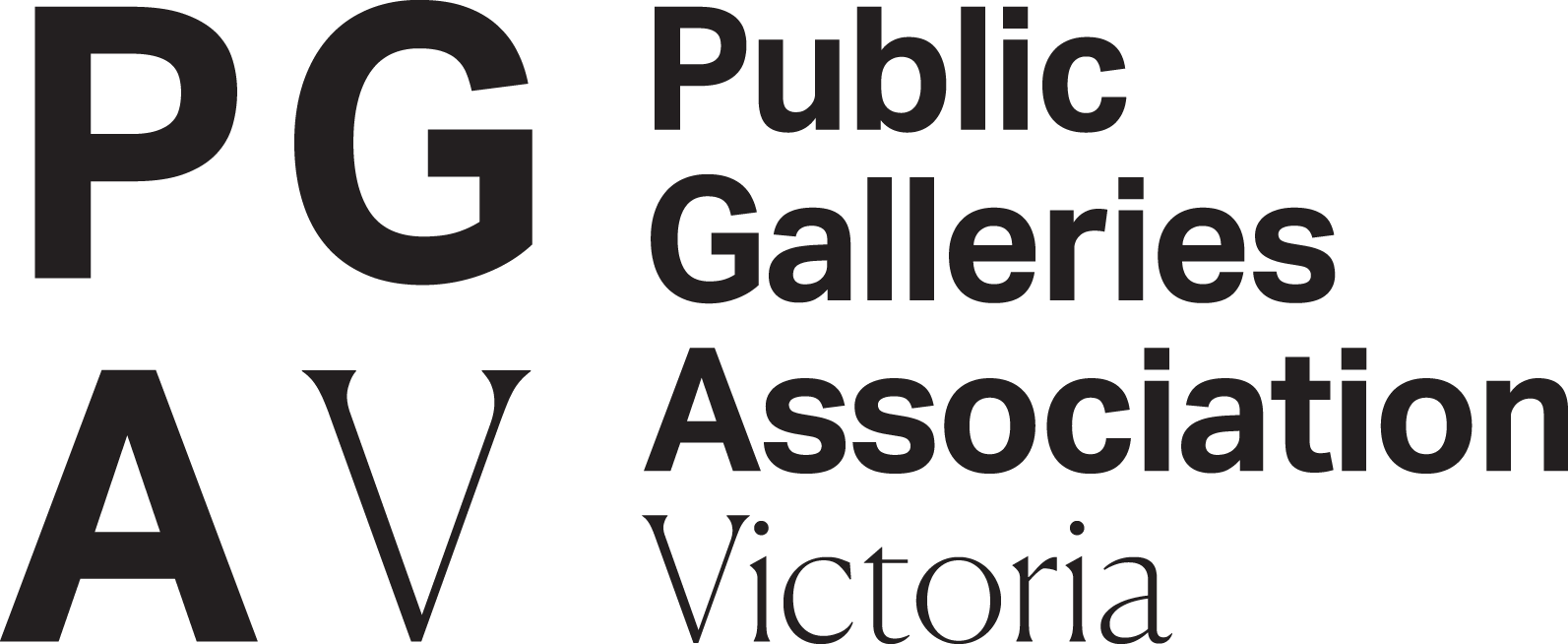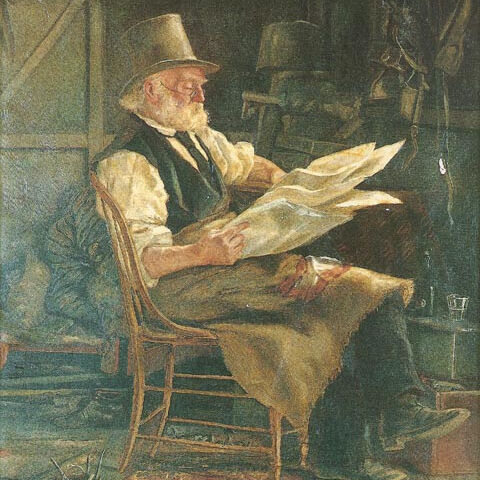
Fredrick McCubbin
This special series of online newsletters celebrate the outstanding contribution of members, past and present, artists and events.
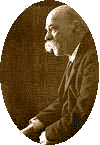
1913
1855-1917
Sepia tined gelatin silver photograph
20.3 x 13.7 cm
Private Collection
In 1888, Frederick McCubbin was appointed Master of the School of Design, National Gallery of Victoria at a salary of 300 pounds a year. He held this position for the rest of his life. Another important event in 1888, was the amalgamation of the Australian Artists' Association with the Victorian Academy of Arts to form the Victorian Artists Society.
Frederick McCubbin acted as a Councillor of the Victorian Artists Society from its inception, and was elected President of the Society, 1903-1904 and 1909. He contributed regularly to their Annual Exhibitions until 1912, when he resigned to become one of the founding members of the Australian Art Association.
On 22 June 1989, the centre upstairs gallery at the Victorian Artists Society was renamed the 'McCubbin Gallery' in honour of Frederick McCubbin, and was officially opened by his daughter, Kathleen Mangan, nee McCubbin.
Art Historian, Andrew Mackenzie OAM details the life and art of Frederick McCubbin for this Newsletter.

AN OLD POLITICIAN, 1879
Oil on canvas, 53.5 x 37 cm
Private Collection
Fredrick McCubbin
Australia 1855, Died 1917
McCubbin was around twenty-four years of age when he painted this work, and at the time was enrolled as a student in the National Gallery of Victoria School of Painting, under Eugene von Guerard. The teachings of von Guerard had a strong influence on the young and impressionable McCubbin and this is evident in these early student works.
After the death of his father on 2 May 1877, McCubbin helped his mother in the everyday business of running their bakery, as well as doing piece-work as a painter for the 'Carriage, Coach and Wagon Builders and Dealers', Stevenson and Elliott, who were situated at 181 King Street, Melbourne. This was only a short distance from the McCubbin's bakery, which was situated at 165 King Street, Melbourne.
'An Old Politician' was one of his earliest narrative works and depicts George Elliott, the Coach Builder, for whom McCubbin worked. George Elliott was considered a worldly-wise, educated man, who used to like to philosophize. McCubbin's title for this work was therefore more befitting the character of the man, rather than his station.
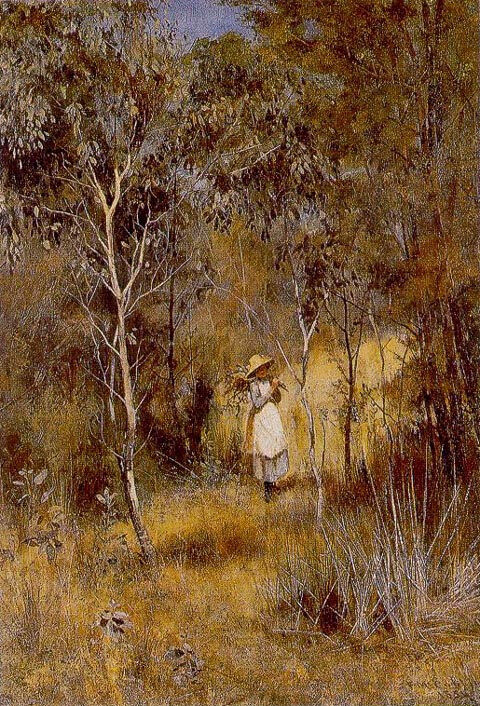
Painted at the Box Hill Artists' Camp in 1886, this work is a companion to 'Lost', 1886, also painted at this site. It is also a companion to 'Found', painted in 1892.
'Gathering Mistletoe' is the first in this series of narrative works, which tells the story of the young girl who goes gathering mistletoe in the bush, only to become lost, and eventually is found.
Note the immature red box eucalypts (Eucalyptus Polyanthemos) captured in this work, which become very much a motif in many of the works painted at the Box Hill Artists' Camp.
The model for the work was Mary Anne or 'Dolly', one of Frederick McCubbin's younger sisters, who was born on 6 March 1857. The painting shows the strong influence of J.B.C.Corot on McCubbin's work at this time, as well as the strong influence of the 'Naturalists'.
GATHERING MISTLETOE, 1886
Oil on canvas, 54 x 39 cm
Private Collection
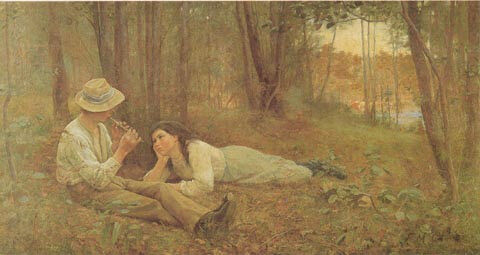
BUSH IDYLL, 1893
Oil on canvas, 119.5 x 221.5 cm
Private Collection
This is a major narrative work by McCubbin, which shows the strong influence of the 'Naturalists' on his work, as well as the influence of J.B.C.Corot.
The work was painted in the bush at Blackburn, and in the far right of the work, McCubbin provides us with a glimpse of cattle grazing at the side of Blackburn Lake.
It is unknown who modelled for the young boy with the penny whistle, however, the young girl was Mary Jane Lobb, who was born in Castlemaine on 1 April 1881. She was one of thirteen children, and married Henry Francis Holzer when she was approximately eighteen years of age. She had eight children, five boys and three girls, and lived to the age of seventy-eight. She died on 21 October 1959.
Further information:
Postcard of Blackburn Lake c. 1905

FEEDING TIME, 1893
oil on canvas, 74 x 125 cm
Private Collection
This work depicts a domesticated bushland scene, with Frederick McCubbin's wife, Annie, aged 28, feeding her chickens.
In the background is the cottage they were renting, situated at Lot 52 (now number 7), Wolseley Crescent, Blackburn.
The work was purchased in 1894 by the National Gallery of Victoria, and was the first Frederick McCubbin work to be acquired by a public gallery. It was later exchanged, in 1900, by the National Gallery of Victoria for his work 'A Winter Evening', 1897. In 1901, it was exhibited in the Victorian Gold Jubilee Exhibition.

MARY McCUBBIN, c. 1893
Oil on canvas, 49.5 x 39.4 cm
Private Collection
Mary McCubbin was the second child and first daughter of Frederick and Annie McCubbin, and was born on 4 November 1891, at 86 Rathmines Road, Hawthorn. She was approximately two years of age when this portrait was painted.
Her story is a sad and tragic one, for the records show that she died from convulsions on 30 October 1894, at home, Lot 52, Wolseley Crescent, Blackburn, after climbing out of her pusher and striking her head on cobblestones. When she died, she was only one week away from her third birthday. Annie McCubbin's newest baby, Hugh, was only two months old when Mary died. I believe that Mary's death, was the deciding factor in McCubbin's decision to leave Blackburn, and in his choice of Brighton as their new address, for many of the McCubbin's close friends lived in Brighton at this time.
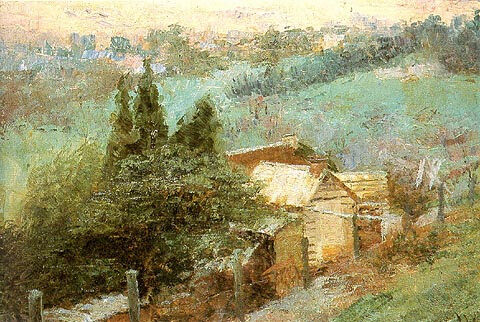
THE OLD COTTAGE, SOUTH YARRA, c. 1910
Oil on canvas, 23.5 x 34 cm
Private Collection
This is another work depicting the gardener's cottage at the end of the almond grove on the 'Como' estate, and was painted around 1910.
Note that in this work, the disciplined depiction of the landscape seems of less importance to McCubbin, than is the capturing of the mood and the capturing of the light on the cottage and the landscape. There are strong elements of impressionism in this work, and more and more during the last years of his life, McCubbin concerned himself with the capturing of light. His daughter, Kathleen, remembered that at this time of his life, he would often refer to his book on JMW Turner for inspiration, and was awed by Turner's skies.
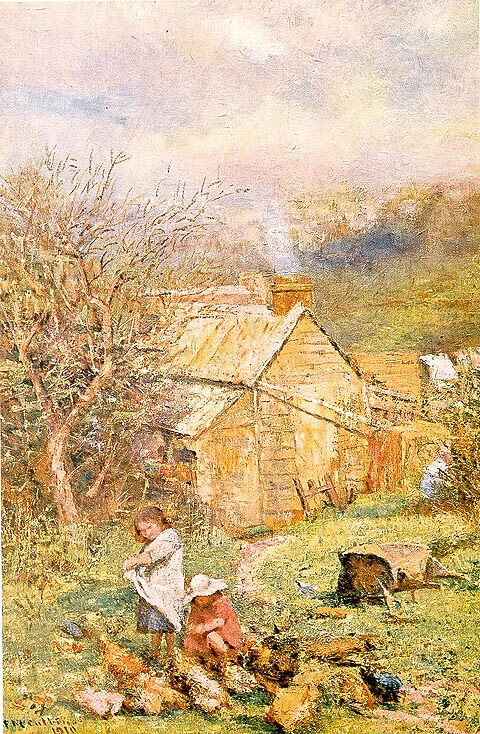
RAIN AND SUNSHINE, 1910
Oil on canvas, 77 x 51 cm
Private Collection
Late in 1907, Frederick McCubbin and his family rented 'Carlesberg', 42 Kensington Road, South Yarra, and this became McCubbin's city residence for the rest of his life. The three acre property, "Carlesberg', overlooked much of the neighboring 'Como' estate, including this, the gardener's cottage, which was situated at the end of the 'Como' estate almond grove.
Mr Thomas, the gardener for 'Como' and his family lived in the cottage, which became the subject for many of Frederick McCubbin's later paintings. Frederick McCubbin depicts three young girls in this work, which was painted in 1910. In the foreground, in the red dress, is his daughter,
Kathleen, at approximately four years of age. Beside Kathleen, is Myrtle Thomas, daughter of Mr Thomas, the gardener, while another of his daughters, Vera, is half hidden by the bushes to the right of the cottage.

GUM LEAF (SOUTH YARRA LANDSCAPE), 1915
Oil and gum leaf, 10.3 (at deepest point) x 21.5 cm
Private Collection
A remarkable work by Frederick McCubbin, which in its portrayal of the landscape, bears a slight resemblance to Arthur Streeton's work 'Golden Summer, Eaglemont', 1889, although at this stage of McCubbin's life, it is more likely to be a South Yarra landscape.
It was produced on a specially prepared (sized) gum leaf, for sale on Remembrance Day, Friday 17 December 1915, to help raise funds for the returning servicemen and women. McCubbin also painted scenes on fan shaped pieces of cardboard. McCubbin's works sold for ten shillings (one dollar), while many other artists taking part, including Jo Sweatman and Dora Serle, sold their works for six pence (five cents).

AN INSIGHT INTO THE LIFE OF FREDERICK McCUBBIN AND HIS ART BY LEADING ART HISTORIAN ANDREW MACKENZIE OAM
'Frederick McCubbin, artist and Drawing Master, was born at 165 King Street, Melbourne on 25 February 1855. He was the third of eight children, having three brothers and four younger sisters, and was the third son of Alexander McCubbin, baker and Annie McCubbin, nee McWilliams.
During the 1860's, he was educated at William Willmott's West Melbourne Common School, and St. Paul's School, Swanston Street, Melbourne. This formal education ceased around 1869 when his father secured for him a position in a solicitor's office, where he worked as a solicitor's clerk.
Around 1870, he enrolled in evening classes at the Artisan's School of Design, Lygon Street, Carlton and from 1871, he was apprenticed for five years as a coach painter with Stevenson and Elliott. Prior to this, he had helped his family with running their bakery business, by driving one of the bakers' carts.
In 1872, he enrolled in the School of Design, National Gallery of Victoria, and studied drawing under Thomas Clark. He continued his studies there under Oswald Rose Campbell, who was appointed Drawing Master of the National Gallery School in 1876. In 1874,
Tom Roberts also enrolled in the School of Design, National Gallery of Victoria, and McCubbin and Roberts became close friends. McCubbin's fellow students gave him the nickname 'The Proff', because of his philosophizing and strong views, while Roberts was nicknamed 'Bulldog'.
McCubbin also studied at the Victorian Academy of Arts and exhibited in their Annual Exhibitions of 1876 and 1879–1882. He sold his first painting 'View near Fisherman's Bend' from their 1880 exhibition, and in 1882, was awarded a Silver Medal in the Academy life-class and was elected an Associate of the Academy.
In 1877, McCubbin joined the School of Painting, National Gallery of Victoria under the instruction of Eugene von Guerard. Fellow students receiving instruction included Tom Roberts and C.D.Richardson.
On 2 May 1877, Frederick McCubbin's father, Alexander died from severe apoplexy accelerated by accidentally falling down a flight of stairs. Frederick McCubbin took on the responsibility of running the family business, which remained listed under Mrs McCubbin's name in King Street, until 1888.
During the late 1870's and early 1880's, McCubbin produced a number of black and white illustrations for the Australasian Sketcher and Illustrated Australian News.
In 1879, he produced one of his earliest narrative works, 'An Old Politician', which was exhibited at the ninth exhibition of the Victorian Academy of Arts.
In 1880, McCubbin became an active member of the newly formed Buonarotti Society.
In 1881, his eldest brother, William John, died on 9 June from injuries received when he was accidentally entangled in the machinery of a flour mill.
With the retirement, at the close of 1881, of Eugene von Guerard, due to ill health, George Frederick Folingsby took over as the Director of the National Gallery of Victoria and Master of the School of Art. Frederick McCubbin remained under Folingsby's instruction until 1885. One of his student works, produced in 1882, under Folingsby's influence was 'Falls Bridge, Melbourne'. McCubbin was also influenced at this time by the works of Julian and George Rossi Ashton.
Even as a student, his work was being highly acclaimed, and in 1883 he received first prize of 30 pounds from the Trustees of the National Gallery of Victoria in the First Annual Exhibition Of Paintings, By The Students Of The National Gallery. In the following year, 1884, McCubbin again won a prize, this time second prize of 20 pounds for his work 'Home Again' in the Second Annual Exhibition Of Paintings, By The Students Of The National Gallery. Also in 1884, McCubbin produced 'The Letter', one of his earliest narrative works, where he has placed the figure within the Australian landscape. He has moved away from painting various scenes of the city and nostalgic works of the bakery, and has begun to paint plein air, in the bushland close to Melbourne. During 1884, he was introduced to Annie Moriarty, who was later to become his wife, at an Artists' Picnic in Blackburn. Tom Roberts returned in 1885, after a four-year overseas trip to Europe, and on his return was quick to renew his friendship with McCubbin. During the summer of 1885/1886 they established the Box Hill Artists' Camp in Houston's paddock 'on the rise above the bark hut of the owners' and were joined by Louis Abrahams and Arthur Streeton. In the vicinity of the Camp, McCubbin painted his work 'Gathering Mistletoe', 1886 and his much loved work 'Lost', 1886.
1886, was an important year for McCubbin. He was appointed Acting Master and Instructor of the School of Design, National Gallery of Victoria, and during the year, he and Tom Roberts and several other artists, broke away from the Victorian Academy of Arts, and formed the Australian Artists' Association. McCubbin became an active member of its Committee.
In the summer of 1886/1887, McCubbin rented a small cottage near Mentone, with Tom Roberts and Louis Abrahams, and during this summer, produced his important work 'Moyes Bay, Beaumaris', 1887. Arthur Streeton, a pupil of McCubbin's at the National Gallery School of Design in 1886, 1887, and in the first half of 1888, met with the artists during this summer and was invited to join them painting in Mentone, and at their Artists' Camp in Box Hill. Charles Conder was also a student of Frederick McCubbin, and was enrolled in the National Gallery School of Design under Frederick McCubbin in 1889.
In 1888, Frederick McCubbin exhibited four works in The Centennial International Exhibition, Melbourne, 1888, and was appointed Master of the School of Design, National Gallery of Victoria at a salary of 300 pounds a year. He held this position for the rest of his life. Another important event in 1888, was the amalgamation of the Australian Artists' Association with the Victorian Academy of Arts to form the Victorian Artists' Society. McCubbin acted as a Councillor of the Victorian Artists' Society from its inception, and was elected President of the Society, 1903–1904 and 1909. He contributed regularly to their Annual Exhibitions until 1912, when he resigned to become one of the founding members of the Australian Art Association. On 5 March 1889, Frederick McCubbin married Annie Lucie Moriarty at St. Ignatius Church, Richmond, Victoria, and Tom Roberts was his best man. During this year, McCubbin painted the work 'Down on his Luck', with the model for the unsuccessful prospector being his close friend, Louis Abrahams. Tragically, Louis Abrahams was to take his own life in 1903.
On 17 August 1889, McCubbin exhibited five works in the9 by 5 Impression Exhibition held at Buxton's Rooms, in Swanston Street, Melbourne.
His first child, Louis Frederick was born on 18 March 1890, at 86 Rathmines Road, Hawthorn. He was named after Louis Abrahams, and was later to become the Director of the Art Gallery of South Australia.
With the death of George Frederick Folingsby on 4 January 1891, Frederick McCubbin was appointed Acting Director of the National Gallery of Victoria. He held this position until March 1892, at which time the new Director, Lindsay Bernard Hall was appointed. On Hall's appointment, McCubbin resumed his previous position and duties.
His second child, Mary, was born on 4 November 1891, and his third child, Alexander, was born on 3 April 1893.
Late in 1893, McCubbin and his family left Hawthorn to live at Lot 52, Wolseley Crescent, Blackburn. Here he painted his works 'Bush Idyll', 1893 and 'Feeding Time', 1893. 'Feeding Time', was his first work to be acquired by a public gallery, and was purchased by the National Gallery of Victoria. Later, in 1901, the National Gallery exchanged the work for his work 'A Winter Evening', 1897.
His fourth child, Hugh Montgomery, was born at Blackburn on 24 August 1894. Two months later, on 30 October 1894, Annie and Frederick McCubbin were devastated when their daughter, Mary, died after accidentally falling from her pusher and striking her head on cobblestones. Soon after the death, the family moved from Blackburn, to a property on the corner of New Street-West Side and Kinane Street, Brighton. Here, McCubbin's fifth child, John (Sydney) was born on 13 June 1896.
'On the Wallaby Track', 1896 was painted close to his home in Brighton, and in this work, McCubbin has painted his wife, Annie, holding young Sydney in her arms. His sixth child, Nora Sheila, was born at Brighton, on 11 March 1898, and in this year McCubbin was represented in the Exhibition of Australian Art held in Grafton Galleries, London.
In 1899, McCubbin briefly visited Tasmania with his family, and on their return to Melbourne, the family left Brighton and moved to 46 Drummond Street, Carlton. On 24 September 1901, McCubbin purchased a four-acre property, with cottage on Mount Macedon, which he named 'Fontainebleau'. This became his family home and his major painting ground on weekends and during the National Gallery School vacations. During the week, McCubbin resided briefly with his sisters, Whilhelmina and Helen, and his mother, at the Rose of Australia Hotel, which his sisters managed. The Hotel was located on the corner of Bourke and King Streets, Melbourne.
On 22 April 1904, he held an important one-man show 'Mr Fred McCubbin's Exhibition of Australian Paintings' in the Athenaeum Upper Hall, Collins Street, Melbourne. In this show, he exhibited his triptych 'The Pioneer', 1904 which was painted close to his home on Mount Macedon.
In 1905, he rented 'Daneida' in Shipley Street, South Yarra, and in November held a 'Private Exhibition of Pictures' managed by his wife, Annie, in his studio and three of the rooms of the house. Artists exhibiting included Walter Withers, and the women artists, Clara Southern,
Media Enquiries:
Ron Smith OAM Hon FVAS, Victorian Artists Society - Mobile: 0417 329 201
Acknowledgment of traditional owners.
We would like to pay our respects to the traditional owners of the land on which our building stands, their leaders, past, present and emerging.

